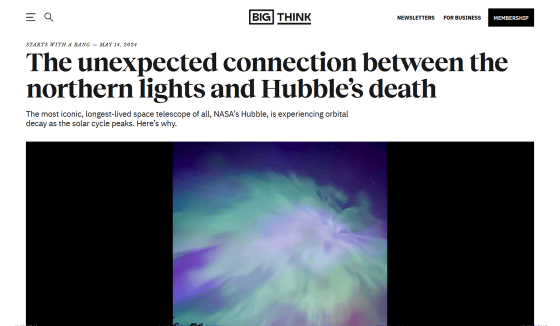What is the surprising connection between the aurora and the 'death of the Hubble Space Telescope'?

by
In the spring of 2024, solar activity increased, and solar flares , explosive phenomena that occur on the surface of the sun, caused the auroras, which are usually only seen in polar regions, to be observed in relatively low latitude areas, including Japan . Many people may have been happy that the auroras became easier to observe, but it turns out that there is a connection between the lifespan of NASA's Hubble Space Telescope and the auroras, and science media Big Think explains the surprising connection.
How the northern lights connect to Hubble's inevitable demise - Big Think
https://bigthink.com/starts-with-a-bang/northern-lights-hubble/

In 2024, the number of sunspots visible when observing the sun will exceed 100 per day on average. Sunspots are areas with a temperature of about 4000 degrees, nearly 2000 degrees lower than the surrounding area, and their number increases as solar activity increases. For example, in 2003, when solar activity was high, there were an average of more than 200 sunspots per day, but in 2009 and 2020, when solar activity was calm, there were an average of 0 to 5 sunspots per day.
The solar activity cycle , which alternates between periods of calm and high activity, lasts for about 11 years, with the most recent solar minimums occurring in 1997, 2009, and 2020. The solar maximum occurred in 1992, 2003, and 2014. Therefore, the next maximum is predicted to occur in 2025 or 2026.
The more active the sun, the more sunspots there are, the greater the number and size of solar flares, and the greater the solar wind , which is high-temperature ionized particles (plasma) blowing out from the sun. The direction in which this solar wind blows out is random, but when it blows towards the Earth, it becomes a solar storm that causes damage to satellites and electronic devices on Earth with electromagnetic waves and particles. The auroras observed around the world on May 10, 2024, were also due to a powerful solar flare that rained down on the Earth as a solar storm.

Solar storms affect not only power grids and electronic devices, but also have a significant impact on the altitude of satellites orbiting the Earth. Many people tend to think that there is a single boundary between the Earth's atmosphere and outer space, but in fact there is no clear line between the atmosphere and outer space, and even thousands of kilometers above the Earth's surface, there are very few atmospheric particles floating around.
Therefore, satellites orbiting in
During more active periods in the solar cycle, solar storms make Earth's atmosphere more energetic, increasing the interaction between the atmosphere and satellites, which in turn increases the drag on satellites, causing them to fall to Earth more quickly, Big Think explains.
When the Hubble Space Telescope was launched in 1990, it was deployed at an altitude of about 620 km, but by the time of the first servicing mission in 1993, its altitude had dropped to about 590 km. This is thought to be because its altitude was significantly lowered during the solar maximum in 1992. When the final servicing mission took place in 2009, its altitude was about 570 km, and it has continued to gradually lower its altitude since then.
The graph below shows the average number of sunspot observations per month in orange and the weekly altitude loss of the Hubble Space Telescope in blue. It is clear that the speed at which the Hubble Space Telescope loses altitude also accelerates during periods of active solar activity. According to Big Think, during the solar minimum, the Hubble Space Telescope's altitude only drops by about 10m per week, but during the solar maximum, it drops by about 300 to 600m per week. Converting this to a yearly altitude loss, during the solar maximum, is equivalent to more than 10km per year.

The 25th solar cycle, which is occurring at the time of writing, is expected to be much stronger than the 23rd and 24th solar cycles, and the altitude of the Hubble Space Telescope is predicted to fall by more than 10 km between January 1 and December 31, 2024. In addition, since the peak of the 25th solar cycle is expected to come in 2025 or early 2026, it is almost certain that the altitude of the Hubble Space Telescope will continue to lose altitude in the future.
The Hubble Space Telescope is expected to fall below 500 km altitude for the first time in history by the end of 2026, and if the altitude drops further during the 26th solar cycle, the altitude will drop significantly even during the solar minimum. Therefore, Big Think points out that if work is not done to raise the altitude of the Hubble Space Telescope, it will burn out before the solar maximum of the 27th solar cycle.
Although the long-term trend of the decline in the altitude of satellites due to the solar activity cycle can be predicted, it is not possible to predict in detail the exact timing and point of re-entry into the atmosphere. Therefore, it is possible that the Hubble Space Telescope or a satellite could re-enter the atmosphere uncontrollably, causing damage on Earth. Big Think argued that NASA scientists should consider having orbiting satellites and spacecraft enter the atmosphere in a controlled manner to reduce the damage caused by satellite re-entry.
Related Posts:
in Science, Posted by log1h_ik







